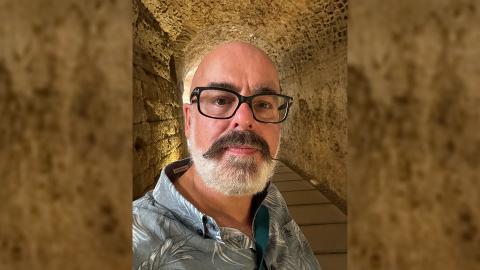
Who are the 'bog people'? The accidental mummies from Northern Europe
Known as ‘bog people’ or ‘bog bodies’, the corpses of mostly Iron Age humans have been mummified naturally by the biochemical composition of the peat bogs.
Image: The Tollund Man is one of the most well-preserved examples of 'bog bodies' | Ancient Murders Unearthed
The Ancient Egyptians were known for many things, one of which was the deliberate preservation of dead bodies through the process of mummification. Whilst Egyptian mummies are known the world over, you might be surprised to discover that in the peat bogs of Northern Europe, over a thousand remarkably preserved ‘accidental mummies’ have been turning up.
Known as ‘bog people’ or ‘bog bodies’, the corpses of mostly Iron Age humans have been mummified naturally by the biochemical composition of the peat bogs. The natural phenomenon has preserved bodies that date back as far as 8000 BC and as recently as World War II.
What’s more, many of the bog people suffered rather gruesome, protracted and disturbing deaths.
The environment
Bog people have been found throughout Northern Europe – mostly in Ireland, Denmark, the UK, Germany and the Netherlands – and the unifying factor amongst all the discoveries is the presence of peat. Bog bodies are found in peat bogs, an environment best described as a dense wetland filled with partially decaying vegetation, mostly sphagnum moss. When this accumulates over time, it creates peat.
This unique environment is sustained through a set of specific physical conditions, such as low temperatures and constant moisture. This, in turn, makes the surrounding water highly acidic and low in minerals and oxygen, which helps to inhibit bacterial growth and therefore prevent the decaying of organic matter. In effect, a peat bog is the perfect natural refrigerator in which to preserve human bodies.
Iron Age uses
Although bog bodies have been found dating back thousands of years, most that have been discovered date from a specific period during the Iron Age and Roman Era, roughly between 700 BC and 200 AD.
For Iron Age and Roman Era communities, peat bogs were an important resource to exploit - they’d harvest the peat to use as a fuel source; collect a form of iron ore known as bog iron, which could be used to create weapons and tools; they'd hunt the birdlife that lived on the bog, and they'd use the moss to weave and create objects of use.
Famous bog people
The practice of peat digging continued throughout the centuries, and during the 1600s, peat diggers began to come across bodies. Many of the early ones found were removed and given Christian burials on local church grounds, as it was believed the bodies were not that old.
As interest in antiquities grew during the 19th century, people began to view bog bodies differently and started to realise they could be ancient in origin. Since then, several discoveries have been made.
In the UK, the most notable of these have been the Lindow Man and the Lindow Woman, who were both found at different times in a peat bog in Cheshire. The Lindow Woman was discovered first in 1983 by commercial peat-cutters. Scientific analysis revealed her preserved human head still contained bits of her brain as well as an eyeball. Carbon dating placed the woman alive during Roman Britain, around 250 AD.
The Lindow Man was found a year later by the same peat-cutting company, and carbon dating suggested he lived sometime between 2 BC and 119 AD. More intact than the Lindow Woman, he caused quite a media stir as it was revealed he died a rather violent death.
Outside the UK, many well-preserved finds have come from Denmark. The Tollund Man was found in 1950 near the Danish town of Silkeborg and was dated to the 5th century BC. He is arguably the best-preserved body (especially face) from the ancient world. Although the environment of the peat bog has caused the Tollund Man’s skin to turn a dark blue and black colour, the features on his face are remarkably detailed. In fact, when the body was first discovered, people believed they were looking at a recent murder victim.
Other notable examples include the Graubelle Man, also discovered in Denmark and dated to the late 3rd century BC. He was so well preserved that researchers could even take his fingerprints. The Yde Girl from the Netherlands, who was believed to be 16 years old when she died, lived sometime between 54 BC and 128 AD. Still attached to her head was her long reddish-blonde hair.
Cause of deaths
A consistent theme amongst all the bodies is the violent nature in which they died. The Tollund Man was hung, the offending rope left tied around his neck. The Yde Girl was strangled, the Graubelle Man had his throat cut, whilst the Lindow Man suffered the same fate but with added violence. He was said to have been killed three times by someone who knew how to kill slowly. The Lindow Man had been hit on the head (enough to stun but not kill) and strangled to the point of death before his throat was sliced open.
This has led experts to believe that many of the bog people were human sacrifices, killed in a ritualistic manner to appease the gods. The stomach contents of the victims have even been investigated, with the results supposedly supporting the theory of sacrifice. The melee of ingredients in their last meals hints toward ritualistic meaning.
For example, before he died, the Graubelle Man ate a porridge made from around 60 different types of plants, which contained ingredients that would have caused him to at least hallucinate and, at worst, slip into a coma.
The Lindow Man ate a charred barley-based meal, probably an ancient griddlecake. The charring is crucial as it hints towards an ancient form of taking the short straw. The person who drew the burnt piece of cake from a bag was the volunteer. Was the Lindow Man, therefore, a willing participant in a human sacrifice ceremony?
The way the Tollund Man was placed naked in a foetal position in the bog has also led researchers to believe he was killed in a ritual sacrifice. Items such as cauldrons have even been unearthed in the bogs as well, suggesting the Iron Age people used offerings to appease the gods and perhaps a human sacrifice was the ultimate offering in times of desperate need.
An unusually high number of bog bodies also show signs of physical deformities ranging from diseased joints and curved spines to dwarfism and extra thumbs. Were these people seen as special and targeted for sacrifice? Given the ethereal nature that peat bogs exude, it’s easy to see how the ancient people may have viewed them through a spiritual and divine lens.
However, the theory of human sacrifice cannot be applied to every bog body found. Some might have been genuine cases of death by bog, people who wandered out into the dangerous environment and never returned. Others might be simple cases of murder, with the victim’s body dumped in the bogs to hide it.




















